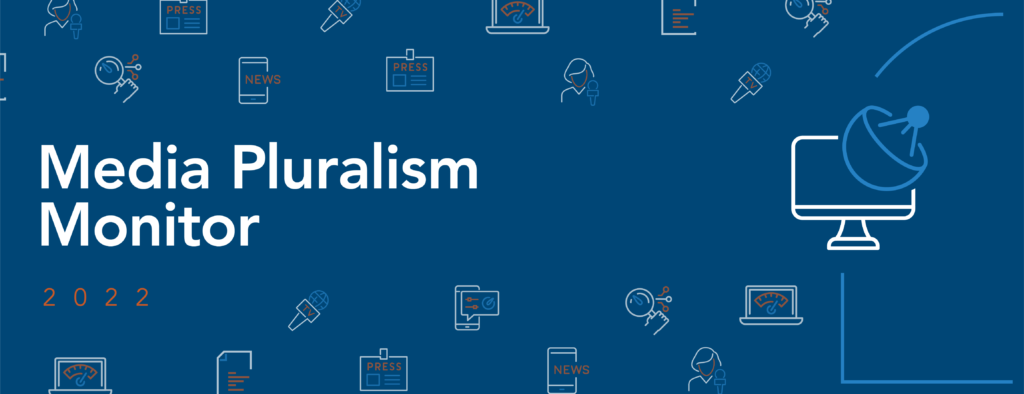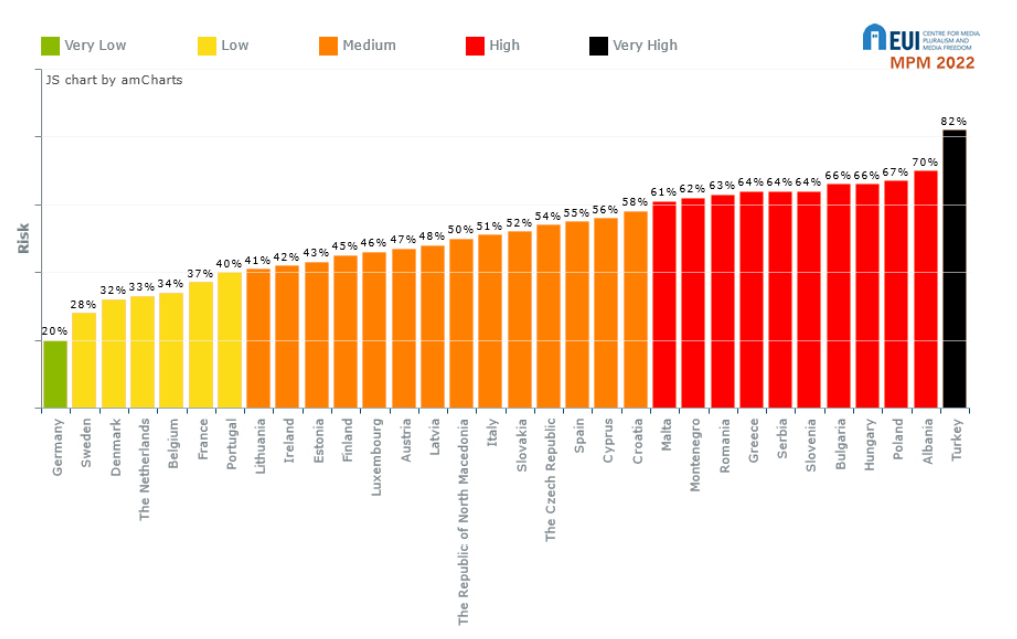
For the first time since the implementation of the Media Pluralism Monitor in 2014, the Media Pluralism Monitor report features a general ranking of countries based on their average risk level in the four areas analysed: fundamental protection, market plurality, political independence, and social inclusiveness.
Why was there no ranking in the MPM so far?
The MPM is a research tool that was designed to identify and measure potential risks to media pluralism in the Member States of the European Union, taking into account a broad and holistic definition of media pluralism. The genesis of the MPM dates back to 2007, with the publication of the Staff Working Document on Media pluralism in the Member States of the European Union (European Commission, 2007), and to 2009 with the publication of the Independent Study on Indicators for Media Pluralism in the Member States – Towards a Risk-based Approach (Valcke et al., 2009), which aimed to define a set of indicators and a methodology that might be useful in assessing and measuring threats to media pluralism in the EU Member States.
The approach of the 2007 Staff Working Document (European Commission, 2007) and of the 2009 Study (Valcke et al., 2009), in addition to adopting a risk based approach, was specifically chosen to avoid assessments that might have relied on a limited number of indicators, usually ones focusing on the transparency in, and the concentration of the media market, and to base the analysis on a more holistic dataset that would take into account many different components of the media system, from the perspective of supply, distribution and use, and covering pertinent legal, economic and socio-cultural considerations. The definition of media pluralism that has been adopted encompasses many aspects, from merger control rules and concentration issues, to content obligations connected to broadcasting licensing systems; from the independence and status of public service broadcasters, to editorial freedom from commercial interests; from the professional condition of journalists, to the relationships between media and political actors; from the representation of minorities, to media literacy. It “implies all measures that ensure citizens’ access to a variety of information sources, opinion, voices, etc., in order to form their opinion without the undue influence of one dominant opinion forming power” (European Commission, 2007).
Compared to the original Study, the MPM has been substantially revised: while the list of the indicators and the tool itself have been updated to acknowledge the digital developments and the consequently evolving definition of media, the core philosophy and the general logic of the methodology was kept. The conceptual basis of the MPM tool is still founded on a broad definition of media pluralism that goes beyond a narrow focus on the economic perspective and media market concentration (European Commission, 2007; Brogi, 2020) – aspects that, despite being the most measurable and the most used as indicators in policymaking, only partially describe the state of play in relation to media pluralism in a given country.
The MPM conceives of media pluralism in its multiple components: the peculiarity of the MPM is that it does not have a preference for a specific notion of media pluralism; instead, it builds on the different national and European traditions and definitions so as to elaborate a set of indicators that tend to cover all of the possible aspects that are involved in the definition of media pluralism in a broad European sense, ranging from the protection of freedom of expression and human rights to political pluralism, from the representation of minorities to media literacy, as explained in detail in the chapters above; and, of course, market concentration and transparency of ownership.
As it does not prefer one notion of media pluralism, the MPM, as revised by the CMPF, organises the risks for media pluralism into the four main areas that are described in the chapters above: Fundamental Protection, Market Plurality, Political Independence, and Social Inclusiveness. This allows for an assessment that covers the different components and meanings of “media pluralism,” and for more explicability, granularity and, finally, transparency, in relation to the scores that are proposed. The granularity is, moreover, useful to enable cross-comparability and to inform policy-making.
Based on this logic, the MPM results have always been published by following the structure of the MPM tool – both in the case of the single country reports and in the case of the comparative analysis (such as this report). In this way, it takes into account four different components of a broad notion of “media pluralism”, entailing four areas of risk. Following the rationale of the tool, the CMPF has avoided the publication of general risk scores that might have been misinterpreted. Using the MPM methodology as a matrix, it is evident how any reductio ad unum of the complexity of this type of assessment might be seen as a simplification of a detailed data collection and analysis that follows certain standards of accuracy and comparability.
Ranking countries: a novelty in the MPM2022
Starting from this MPM2022 implementation, the CMPF has decided to introduce the general ranking of the countries, as an additional element of transparency. As the MPM has been described as a tool that measures the “temperature” of the risks to media pluralism in a given country, this general ranking, which includes the actual numerical score for each member state, provides a mapping that can be interpreted as a preliminary triage for the risks to media pluralism in a country, while the causes of the “illness” must be explored with the help of the details given in the analysis of the four areas. The general scores of the countries are calculated as the average of the four area scores of the MPM.

In order to better capture the differences between the scores of the countries, we here provide a chart that uses thresholds that are different to those used for indicators and areas, in order to group the results. The following histogram, therefore, provides a visualisation that is based on these specific clusters: 0-20, very low risk; above 20-40, low risk; above 40-60, medium risk, above 60-80, high risk; above 80, very high risk. This way of clustering is the result of a simple arithmetic averaging that is not fully in line with the conventions of the MPM, as it does not follow from the structures of the questionnaire and the data collection, presently based on a choice between just three levels of risk for each question posed. The five-colour histogram above, however, provides an interesting more nuanced visualisation of the results, based on which, only Germany is very low risk; only Turkey scores as a very high risk, and Malta, Montenegro, Romania, Greece, Serbia, Slovenia, Bulgaria, Hungary, Poland and Albania are flagged as high risk countries. This more granular representation is also to be considered a first test for the CMPF in evaluating the need and feasibility of operating a transition to an even more detailed questionnaire and the future effective assessment of the risks on a five parameters scale. The average score is 51%, which is close to the percentage that has been obtained by Italy, which is, in fact, 16th out of 32 countries, which places it exactly in the middle of the ranking.
The chart shows, moreover, that older EU Member States (the countries of Western Europe) have, predictably, achieved lower scores, while countries that joined the EU in the 2000s, as well as the candidate countries tend to show higher risks. Still, we can find some notable exceptions: in the Baltic countries and the Republic of North Macedonia, the risk is below average, while the Czech Republic and Slovakia are only slightly above it.
There are some caveats: in order to avoid misinterpretations of this ranking, it must be stressed, once again, that the MPM is a tool with which to assess the risks for media pluralism, based on an analysis that takes into account some structural elements that may, or may not, be considered problematic, in order to ensure a plural media environment. The focus of the MPM is not just on finding out what the deficiencies of a media system are, but also whether there are structural conditions that can lead to a deterioration in the freedom of expression and media pluralism in a given context. The rationale behind the Media Pluralism Monitor is that it is “a systematic analytical process, based on predetermined risk criteria, professional judgement and experience, to determine the probability that an adverse condition will occur” (EC Working Document, 2007). This analysis is, then, balanced by some data that constitute a sort of “reality check”: this allows for the assessment of the situation for a given country with regard to both the conditions that are conducive to more or less pluralism, and the effective conditions for the country itself (Brogi, et al., 2021).
It must also be emphasised that the Media Pluralism Monitor is a tool that has been conceived to be implemented on the Member States of the European Union and on candidate countries. The rankings of the scores, which range from 20 in Germany, to 82 in Turkey, are relative to 32 countries only, and they are based on standards that have been developed by the Council of Europe, ones that are common to the constitutional traditions of EU Member States, and on rules that are part of the acquis communautaire: the percentages of risk must thus be read in this relative and comparative context. Comparing this ranking to other rankings that have been produced by renowned NGOs, for instance, the Reporters without Borders’ Index, covering almost all the countries on the globe, and focusing on freedom of expression and the safety of journalists, implies taking into account different methodologies, indicators, scopes, and, consequently, there is no straightforward score-scale comparability.
